In this article, discover best practices for implementing a performance management system that drives success. Looking to evolve your organization's approach to performance management?
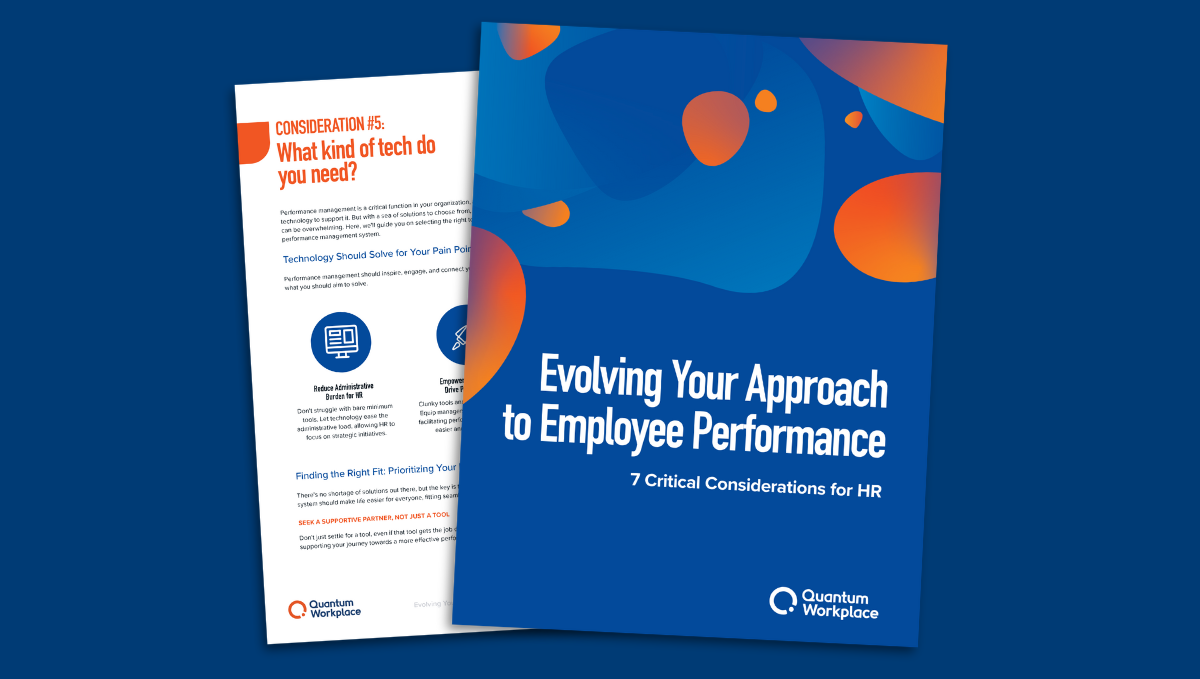

Performance management. Every company needs to do it. But not every company is doing it well.
Traditionally, organizations have relied on clunky, cumbersome, and disengaging approaches to performance management. They’re working with disparate systems, low buy-in, and frustrated managers and employees. Without a strategic direction—and the right tools—your performance management strategy can lead to low adoption and, ultimately, underperformance.

Employees crave fairness, transparency, and ongoing coaching and feedback. When leaders prioritize these things, employees feel connected to the rest of the organization and can do their best work. Our research shows what an engaging performance management approach looks like.
Performance management is the process leaders use to measure, develop, and motivate employee performance. The process should be ongoing to keep a constant pulse on individual, team, and company-wide performance. With continuous performance management, you can empower and engage employees to drive goals and objectives critical to business success. Here’s how:
When managers keep a pulse on employee performance, they can tackle problems and get their teams back on track. They can also outline opportunities that align with each employee to capitalize on strengths and close skill gaps.
Helping employees feel part of the process is the best way to ensure they feel heard, valued, and recognized. You don’t want employees to feel like performance management is happening to them. It should be a shared responsibility between employees and managers and an opportunity for growth and increased impact. Building a performance management approach that engages employees looks like:
When employees are active participants in their performance management journey, they feel a stronger sense of voice and influence, further reinforcing their dedication and motivation to excel.
Having clear and aligned goals alongside regular performance conversations help leaders outline the bigger picture. When employees understand how their daily initiatives make an impact, they feel more connected to their work and its purpose. When employees feel connected to a purpose, they’re more likely to make an impact.
Your company culture is all about the way you get work done at your organization, and your approach to performance is a key part. When you coach employees in a way that motivates and engages them, with ongoing feedback, recognition, and goal alignment, you’ll foster a culture that employees can thrive in.
According to our research on organizational culture, how an organization approaches performance management is a critical part of how employees feel culture within their organization.
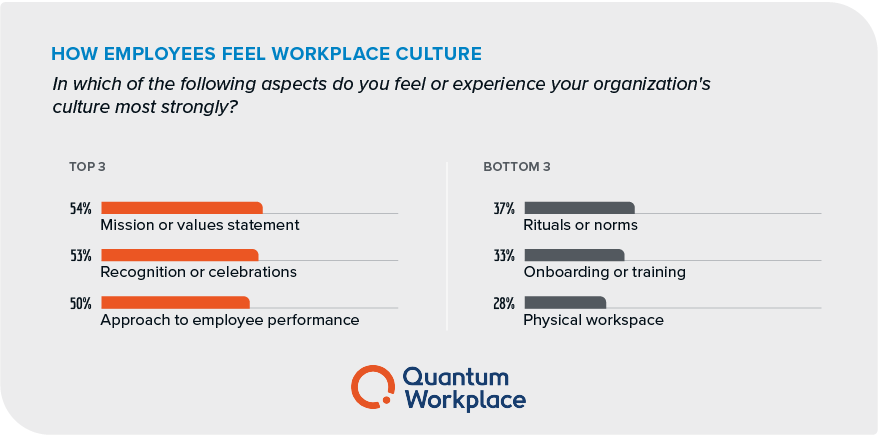
In fact, 50% of employees experience culture most strongly through their employer’s approach to performance.
A good performance management strategy helps employees grow to reach their full potential. Leaders can use performance management to address skills gaps, outline growth opportunities, and bolster employee strengths. It helps managers understand when an employee might be ready for a new project or role. It helps employees feel like the organization is invested in their development and career growth.
When you understand the big picture behind employee performance, you can make decisions that empower employees across the company. An effective approach to performance will help you identify performance impact, growth potential, and retention risk. When you keep a pulse on these metrics, you can give your employees the tools they need to succeed.
Your approach to performance makes all the difference in the employee experience. And the employee experience is a key indicator of whether your employees decide to leave or not. Performance management can be used as an ongoing tool to strengthen employee retention and keep your key players.
‘Productivity’ has earned buzzword status recently. And with good reason. Numerous organizations, driven by productivity concerns, continue to rely on outdated data and assumptions for measuring employee performance.
However, it is crucial to understand that there are effective and ineffective ways to enhance performance. To truly ignite employee impact, leaders need to prioritize the development of performance management strategy that fosters inspiration and motivation. In other words, organizational leaders need to shift their focus away from employee productivity and start inspiring employee impact.
The data below is informed by over 1 million employee voices at more than 9,000 organizations across the United States.
The traditional aspects of performance management, like ratings, rankings, and pay-for-performance don’t engage employees.
But performance management definitely has an impact on engagement. Quantum Workplace research shows that the top drivers of engagement—related to performance management—are recognition, fairness, alignment, feedback, and empowerment.
Leaders can use these drivers to design an approach to performance management that motivates performance, impact, and engagement.
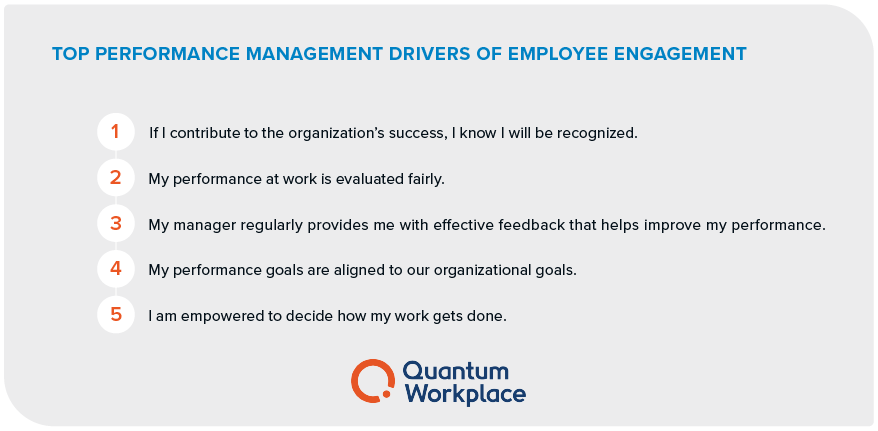
Despite the importance of employee recognition, 1 in 2 employees would like more recognition for their work. Only 37% receive recognition monthly or weekly.
Overwhelmingly, at 71%, employees' most preferred recognition reason is for their performance or accomplishments in their role. By increasing the frequency of recognition, organizations can drive both performance and engagement.
One-on-one meetings between employees and managers are a fundamental pillar of effective performance management. Our research shows that 36% of employees express a desire for weekly one-on-one conversations with their manager.
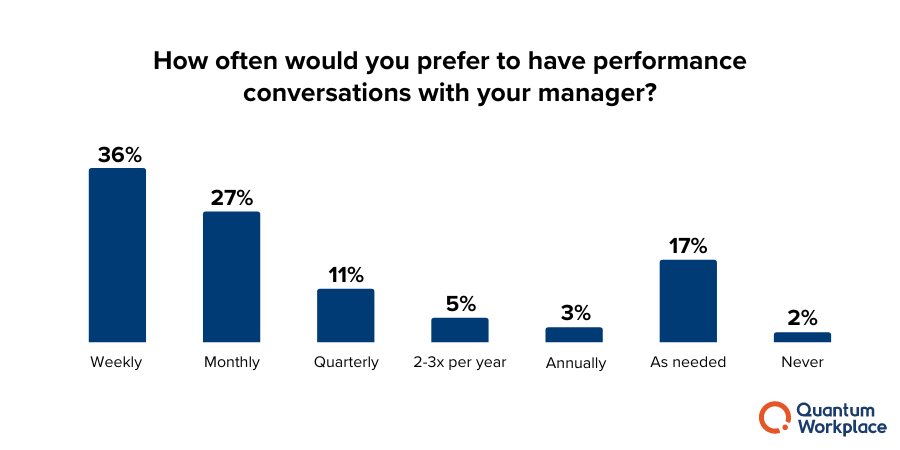
This preference for frequent interaction underscores the value employees place on regular, meaningful engagement with their managers.
When employees are given the opportunity to engage in weekly 1-on-1 meetings, several benefits emerge. Most importantly, these meetings provide a stable platform for employees to discuss their priorities, align with personal and organizational goals, receive feedback, and gain clarity on job expectations.
Let’s dive into some of these benefits using our research as a guide.
Your employees are more likely to be engaged when you meet with them often. In fact, over 71% of employees who have weekly performance conversations are highly engaged. And one trend is becoming remarkably clear: As the 1-on-1 meeting cadence decreases, so does employee engagement. Only 53% of employees are highly engaged when they meet annually with their manager.
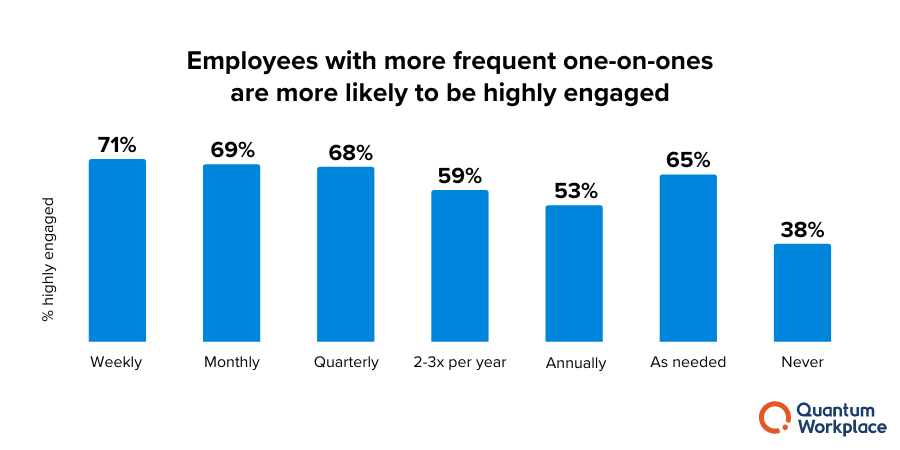
As organizations mature their approach to employee performance, they should aim to increase the frequency of meaningful one-on-one meetings that focus on goal-setting, performance, development, engagement, feedback, and more.
Different work environments require different approaches to performance. In fact, hybrid and remote workers are more likely than their onsite counterparts to want weekly 1-on-1s. 43% of remote workers and 37% of hybrid employees prefer a weekly cadence, compared to 27% of onsite employees.
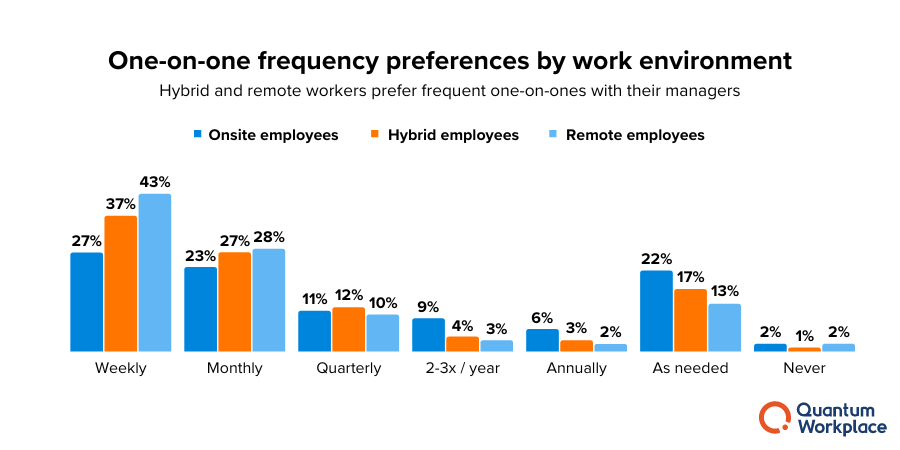
Our research shows that 1 in 2 employees express wanting more feedback, and employees primarily want to receive that feedback directly from their manager.
Employees who receive more frequent feedback are:
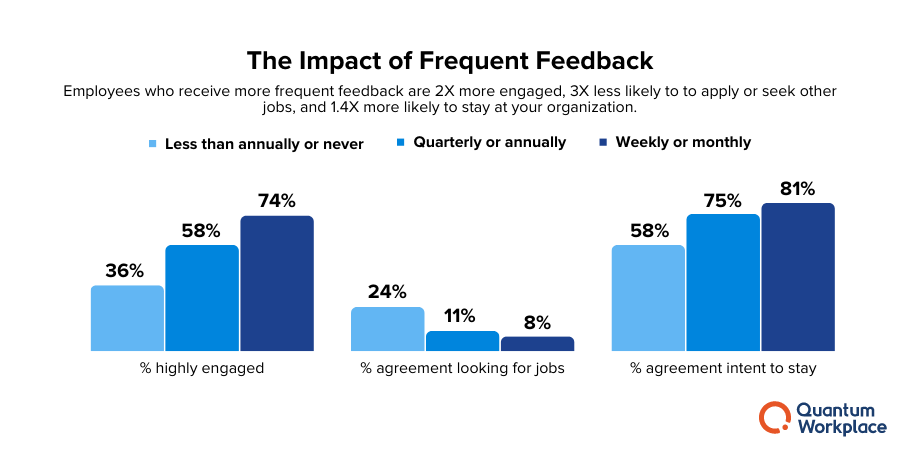
When done well, goal setting can have an enormous positive impact on employee performance. In fact, goal setting has proved to be one of the most powerful management tools to improve performance in today’s workplace.
Our research found that employees who have individual goals set are 2X more likely to be engaged at work. Goal setting and revision frequency appears to be directly related to employee engagement. As collaboration and frequency decreases, employee engagement levels follow suit.
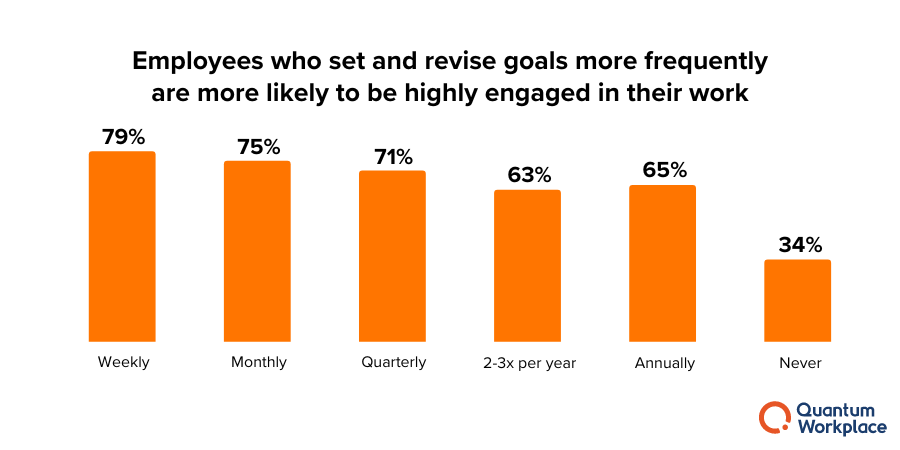
One of the most notable performance management trends is the redefinition of career growth and development.
Of course, most organizations understand the importance of providing career growth and development opportunities for their employees to help boost skills, drive engagement, and retain top talent.
But in order to design an effective development strategy, employers must first understand what ‘growth and development’ means to their employee base.
Our research shows that:
In other words: employees want different things when it comes to their own career growth. It’s more important than ever for managers to individualize employee development using the data they gather from those more frequent one-on-one meetings we discussed earlier in this article.
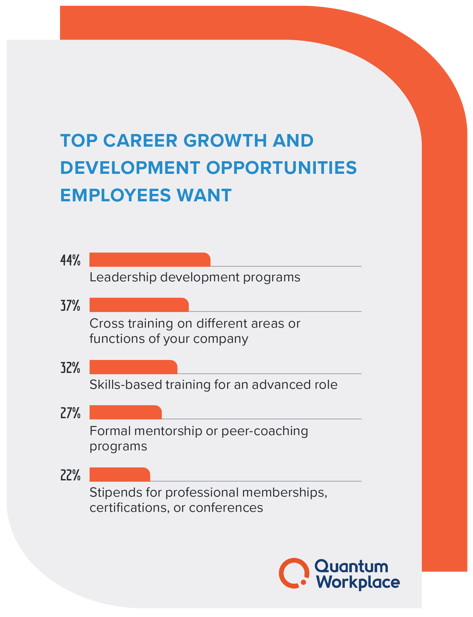
The performance management research above can help leaders across all industries create an engaging approach to performance. Keep these performance management best practices in mind when shaping your strategy.
The annual performance review doesn’t align with employee expectations around performance conversations. It’s not useful for facilitating the coaching and feedback needed to maximize alignment and impact throughout the year.
Employees want to have frequent one-on-ones with their manager.
When one-on-ones happen frequently, teams are more likely to be aligned, efficient, and engaged. While weekly one-on-ones are preferable, ensure you’re holding these conversations at least monthly. With a high meeting frequency, managers and employees can address challenges, questions, and concerns as they come up.
Not to mention, more frequent one-on-ones enable your managers to tailor employee growth and development to the unique needs of individual employees.
When managers and employees set goals collaboratively—and frequently—employee engagement increases.
To maximize employee impact and engagement, managers should help align team and individual goals with organizational goals. This helps employees visualize how their work contributes to the larger organization’s success. Outline why each goal is set and how it contributes to business outcomes.
When employees understand why their efforts are important, they’re much more likely to give their full effort day-in and day-out.
Employee recognition is associated with strong employee engagement levels. That’s why leaders should always provide recognition for employee contributions. Acknowledge employees when they achieve goals, showcase increased effort, and practice valued behaviors. Not only will your employees' engagement levels increase, but they’ll have the motivation needed to continue their efforts in the future.
Employees need feedback that helps them improve. Employees are likely to be engaged when they receive effective feedback from their managers. That’s because helpful feedback fosters a culture of trust and supports employee growth. Ensure your feedback outlines tools and strategies for employees to improve.
Feedback doesn’t always have to be constructive or regulated to a form. 1 in 2 employees want more recognition for their work. And while managers play an important role in giving recognition, organizations should also ensure that managers are recognized frequently for their efforts as well. Encourage employees to request input from peers and managers—asking for both constructive and positive feedback.
Research shows that fair performance evaluations are a top driver of engagement. That’s why leaders should prioritize honest, inclusive, and ongoing feedback. Don’t save all your feedback for a once-a-year performance review. Instead, align, assess, and adjust regularly throughout the year. Ensure you communicate the “why” behind each evaluation and give employees the opportunity to voice their opinions too.
Employee growth and development is not a one-size-fits-all initiative. Our research indicates that ‘growth and development’ means very different things to employees. Focus a good chunk of your one-on-one meetings on what growth and development within the organization looks like for each employee. These discussions can help shed light on what each employee wants and how their needs evolve over time.
If your employees feel like performance management is something that’s happening to them instead of something they’re actively contributing to, you have a big problem. Bringing your employees more actively into the performance process is one way to boost impact across the organization.
One of the most effective ways to do this is to leverage employee surveys to gather feedback on your current performance practices. And then use this feedback to continuously improve your performance management process using employee insight—not the assumptions of your leadership team.
Performance management shouldn’t be hard to build, adopt, and navigate. And that starts by having the right performance management tools. Cumbersome processes and disparate technology (or NO technology) can throw a wrench in your plan and make it more difficult for both employees and management to participate.
There are several ways the right technology solution can help to support and scale your performance management strategy.
Less than one-fifth of HR leaders believe their approach to performance management is effective right now, and 81 percent of leaders are changing their performance management system. A large shift is happening, and the best leaders leverage tech to navigate it. Here’s how performance management tools can help you:
GoalsA robust goal management software helps teams set, track, and elevate goals to the entire organization. That way, every employee can see—and contribute to—the big picture behind business objectives. |
|
RecognitionAn effective employee recognition tool will help people across the organization celebrate each other. The right software will connect recognition to key goals and values, motivating employees to continue important behaviors. |
|
1-on-1sOne-on-one meeting software facilitates employee manager conversations, increasing clarity and communication. Leaders can launch a 1-on-1 anytime, from anywhere, and integrate goals and feedback for better conversations. |
|
FeedbackA two-way feedback solution will help your employees become better team members and managers become better coaches. With flexible frameworks, employees and managers can ask for or provide feedback to grow in their role. |
|
Talent reviewsTo make strategic people decisions, leaders need to understand the overall state of their talent. With an intuitive talent review tool, leaders can elevate top performers and talent risk to take the right action and grow. |
|
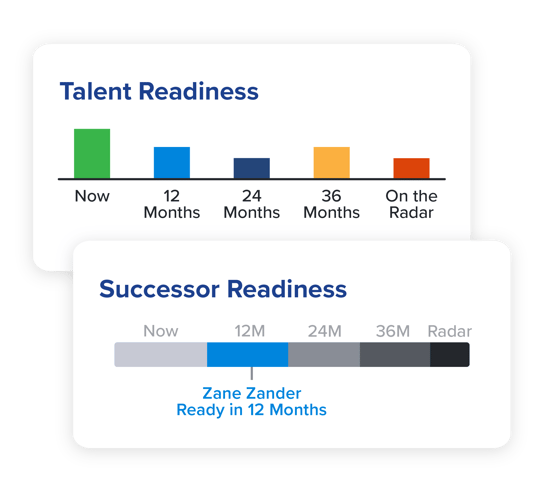 |
Succession planningLeaders need effective tools to help them plan for the future, ensuring they have the right people in the right jobs at the right time. Succession planning software helps leaders capture successor interest and readiness to plan for critical roles—while helping potential successors grow and develop to be ready when called upon. |
Consider these performance management trends and best practices when shaping your approach. By coaching performance with employee engagement in mind, you’ll help employees reach their full potential and drive consistent business outcomes
Is performance management a priority for your organization this year? Learn more about how Quantum Workplace can help you make performance management easier. Get a demo today!
Published July 20, 2023 | Written By Kristin Ryba